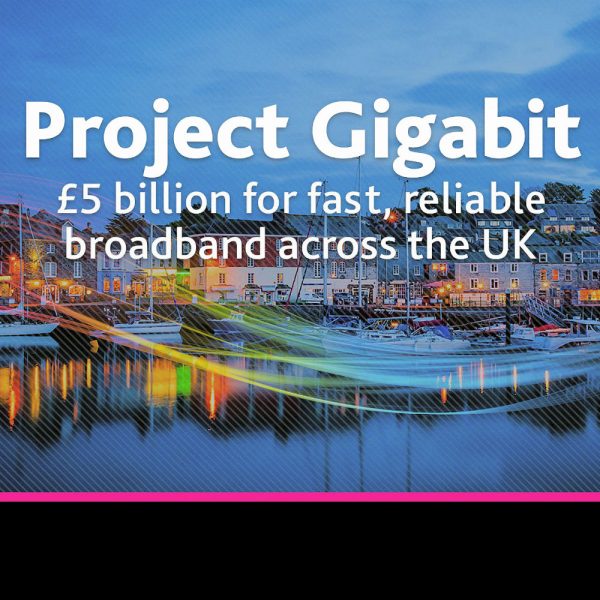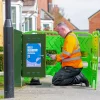BDUK Summarise Progress of UK Project Gigabit Broadband Rollout Contracts

The Government’s (DSIT) Building Digital UK agency has today finally started to publish monthly updates on the delivery progress of contracts that have been awarded under their £5bn Project Gigabit broadband rollout scheme, which among other things reveals that some 150,730 contracted premises have already been built out of a planned total of 1,002,270 (October 2025).
Just to be clear. The figures in this update are not directly comparable to the figures published in BDUK’s official statistics releases; they track the number of contracted premises to which the supplier has delivered a gigabit-capable connection, whereas the official statistics report on the number of premises that have received a gigabit-capable connection as a result of public BDUK subsidy (i.e. those also cover other schemes, like vouchers etc.).
At present over 88% of UK premises can already access a gigabit-capable network (here) and Ofcom separately forecasts that this could hit c.97% by May 2027 (here). Most of this has been delivered by commercial deployments (predominantly focused on urban and semi-urban areas), but there are some areas in the final 10-20% of premises that are simply too expensive for commercial providers to tackle.
Advertisement
Project Gigabit was originally established in 2021 to help extend broadband ISP networks capable of delivering download speeds of at least 1000Mbps (1Gbps) to achieve “nationwide” coverage (c.99%) by 2030 2032 (here) – focusing on the commercially unviable areas (usually rural and semi-rural locations). The project has already committed most of its budget up to 2030, but there are still some contracts yet to be awarded and others that have failed or been scaled-back (here, here and here).
At this point it’s worth remembering that all of the listed contracts below were awarded at different times. For example, Openreach’s cross-regional (Type C) deployments are some of the most recent ones – awarded between 2024 and 2025, while the contracts for North Dorset (Wessex Internet), Teesdale (GoFire) and a few others are the oldest and awarded all the way back in 2022. In short, they’re all at different stages of development.
Project Gigabit – Contracted Premises and Built Premises by Contract (Oct 2025)
| Contract | Supplier | Contracted premises | Built contracted premises |
| Bedfordshire, Northamptonshire and Milton Keynes | CityFibre | 21,030 | 1,580 |
| Bucks, Herts and East of Berks | CityFibre | 19,090 | 2,140 |
| CO1 Lancashire, West Berkshire, Staffordshire, Surrey, Hertfordshire, Wiltshire and Gloucestershire | Openreach | 54,340 | 3,810 |
| CO2 Devon, Mid Wales and South East Wales | Openreach | 42,270 | 2,790 |
| CO3 North Herefordshire, North Wales, Shropshire and South West Wales | Openreach | 52,060 | 50 |
| CO4 South Devon, Mid Devon and North Somerset | Openreach | 37,110 | 50 |
| CO5 Essex and North East England | Openreach | 24,710 | 90 |
| CO6 Rest of Scotland | Openreach | 65,070 | 0 |
| CO7 Worcestershire | Openreach | 22,600 | 0 |
| Cambridgeshire | CityFibre | 39,070 | 6,570 |
| Central Cornwall | Wildanet | 9,720 | 6,640 |
| Cornwall and Isle of Scilly | Wildanet | 14,540 | 2,010 |
| Cumbria | Fibrus | 53,540 | 22,090 |
| Derbyshire | Connect Fibre | 12,500 | 330 |
| Dorset and South Somerset | Wessex Internet | 7,240 | 1,470 |
| Durham | GoFibre | 4,460 | 4,260 |
| East Gloucestershire | Gigaclear | 3,550 | 110 |
| East and West Sussex | CityFibre | 41,940 | 880 |
| Hampshire | CityFibre | 55,570 | 4,300 |
| Kent | CityFibre | 46,080 | 950 |
| Leicestershire and Warwickshire | CityFibre | 38,230 | 4,720 |
| Lincolnshire and East Riding | Quickline Communications | 47,800 | 9,210 |
| New Forest | Wessex Internet | 15,120 | 7,740 |
| Norfolk | CityFibre | 48,950 | 8,650 |
| North Dorset | Wessex Internet | 6,710 | 6,490 |
| North East Staffordshire | Connect Fibre | 5,960 | 1,080 |
| North Oxfordshire | Gigaclear | 4,180 | 2,660 |
| North Shropshire | Freedom Fibre | 3,410 | 3,410 |
| Northern North Yorkshire | Quickline Communications | 33,810 | 3,640 |
| Northumberland | GoFibre | 3,830 | 3,830 |
| Nottinghamshire and West Lincolnshire | CityFibre | 27,820 | 0 |
| South Oxfordshire | Gigaclear | 5,310 | 1,150 |
| South West Cornwall | Wildanet | 11,120 | 6,170 |
| South Wiltshire | Wessex Internet | 18,240 | 3,610 |
| South Yorkshire | Quickline Communications | 13,290 | 6,320 |
| Suffolk | CityFibre | 65,710 | 11,670 |
| West and Parts of North Yorkshire | Quickline Communications | 26,310 | 10,090 |
| TOTAL | 1,002,270 | 150,730 |
We should point out that CityFibre’s progress under the £58.6m (public subsidy) contract for rural parts of Nottinghamshire and West Lincolnshire (Lot 10) is perhaps a bit misleading (0 premises), since Connexin originally held this until only a few months ago – after they were acquired by CityFibre. Connexin only began the build phase at the end of last year (here), thus its delivery has been disrupted by the consolidation.
Advertisement
The above is an example of why it’s important to understand the context behind each contract before judging its delivery progress, since a face-value assessment will overlook some of the realities. Speaking of which, some of the contracted figures may differ from the original announcements, which reflects recent contract modifications (the scope of delivery can increase or decrease, such as due to commercial networks going further than expected or builds costing more than expected etc.).
Otherwise, we intend to keep an eye on these progress reports and post occasional updates, but we won’t be spamming by publishing monthly progress updates.
Mark is a professional technology writer, IT consultant and computer engineer from Dorset (England), he also founded ISPreview in 1999 and enjoys analysing the latest telecoms and broadband developments. Find me on X (Twitter), Mastodon, Facebook, BlueSky, Threads.net and Linkedin.
« Ofcom Publish Final Results of UK 5G Mobile Auction for 26GHz and 40GHz
Advertisement
Leave a Reply Cancel reply
Privacy Notice: Please note that news comments are anonymous, which means that we do NOT require you to enter any real personal details to post a message and display names can be almost anything you like (provided they do not contain offensive language or impersonate a real person's legal name). By clicking to submit a post you agree to storing your entries for comment content, display name, IP and email in our database, for as long as the post remains live.
Only the submitted name and comment will be displayed in public, while the rest will be kept private (we will never share this outside of ISPreview, regardless of whether the data is real or fake). This comment system uses submitted IP, email and website address data to spot abuse and spammers. All data is transferred via an encrypted (https secure) session.






















































I don’t know, barely 15% of the total awarded actually completed seems incredibly poor for a scheme that’s been going since 2021. I know it’s taken AGES for them to award some of the contracts but it’s still pretty poor overall.
Actually, the figures make no mention of the contracts that have fallen off the perch that are waiting to be sorted out.
As very little or no build has occurred for these, the total percentage completed would be even less.
Cheshire, for example, had 15k properties in the Lot 17 contract before Freedom Fibre backed out in March.
If BDUK intends to include these (and those in other areas) in new contracts, then I think they should be part of the list to give a fuller picture of planned vs delivered.
If a property hasn’t been built to then it can be for of many reasons.
A failed contract is just one such reason and doesn’t mean it won’t be built to (eventually…) just like any other property in the pipeline.
The new figures will hopefully be updated monthly as stated.
If they are then the public will, for the first time, be able to see relatively up to date progress over time. The snapshot of BDUKs data was just 3 days ago which is a big improvement on the 6 month old data published in the infrequent official statistics.
The idea of having a target date for 99% gigabit completion seems foolish when so much depends on commercial decisions outside the control of BDUK.
Well it’s certainly not working here:
Sussex CityFibre 41,940 880
Kent CityFibre 46,080 950
even rounded up by 1,000s, 1/46 or half a percent..
No not necessarily. More public subsidy (on top of the £5Bn from Project Gigabit) and investment in new technologies may be needed.
If services like a FTTP line can’t be delivered, The government will probably want to look at investing in LEO satellite services, which can at least deliver downstream speeds above 100mbps.
It might be better to simply spend a few billion on the final 1%, especially those with only a slow or unreliable ADSL only line. Work on this could begin now.
1/46th would be 2%. Half a percent, per hundred, would be 1/200th.
As already mentioned doesn’t mean much. Getting fibre to the settlements is going to be much of the work and leaves zero premises covered.
If there were fibre nearby ready to serve these areas many of them wouldn’t be part of the intervention area. Time to judge progress based on premises completed would be much nearer the end of the contract period.
I guess we’ll see where we are in a year…
Still no properties completed in Worcestershire, nor Scotland, I suppose because it has taken so long to sign off these contracts.
Openreach capacity seems overstretched.
For hopefully obvious reasons there’s a bunch of work at the start that connects zero properties. The properties need a network to connect to, and that spine from the exchange where the equipment is to the town, village or hamlet’s main roads gets built first.
The supplier can easily do the majority of the work to serve a smaller settlement without having a single property able to order. Proportion of premises covered isn’t a useful metric for evaluating progress.
Not long ago, a BDUK announcement told us that the number of Norfolk properties for intervention had been increased from just over 62,000 to nearly 75,600 although Cityfibre’s website still states the c62,000 number. However, the Norfolk total given in the above table for ‘contracted premises’ with Cityfibre is just under 49,000. No doubt the actual contract between BDUK and Cityfibre is ‘confidential’ but it does suggest there is some doublespeak going on. Can we expect Whitehall to claim they have completed the contract and pull the plug when Cityfibre reach 49,000 in Norfolk?
Also: It would be interesting to know if the other locations given in the table have similar inconsistencies. As others have pointed out, when you take into account the other Project Gigabit gaps, what does this latest information actually represent?
The number in the intervention area isn’t the same thing as the number under contract. None of the contracts are for every property in the respective intervention area. There’s not enough funding to do that.
Contracted properties a supplier has agreed to cover that many with however much subsidy, that’s all. To cover more needs another contract.
Regardless of the caveats it would be interesting to plot time since contract award Vs # or % of contracted premises passed – some of these are still shockingly low despite the contracts being in place for years now…